This study examines consumer preferences between international, national, and isolated brands in the Indian market, utilizing a multinomial discrete choice model to identify key product attributes influencing decisions. It highlights the complexity of brand dynamics in emerging markets, where both cultural differences and market saturation affect consumer choices. The findings provide valuable insights for managers regarding brand positioning and marketing strategies in competitive environments.
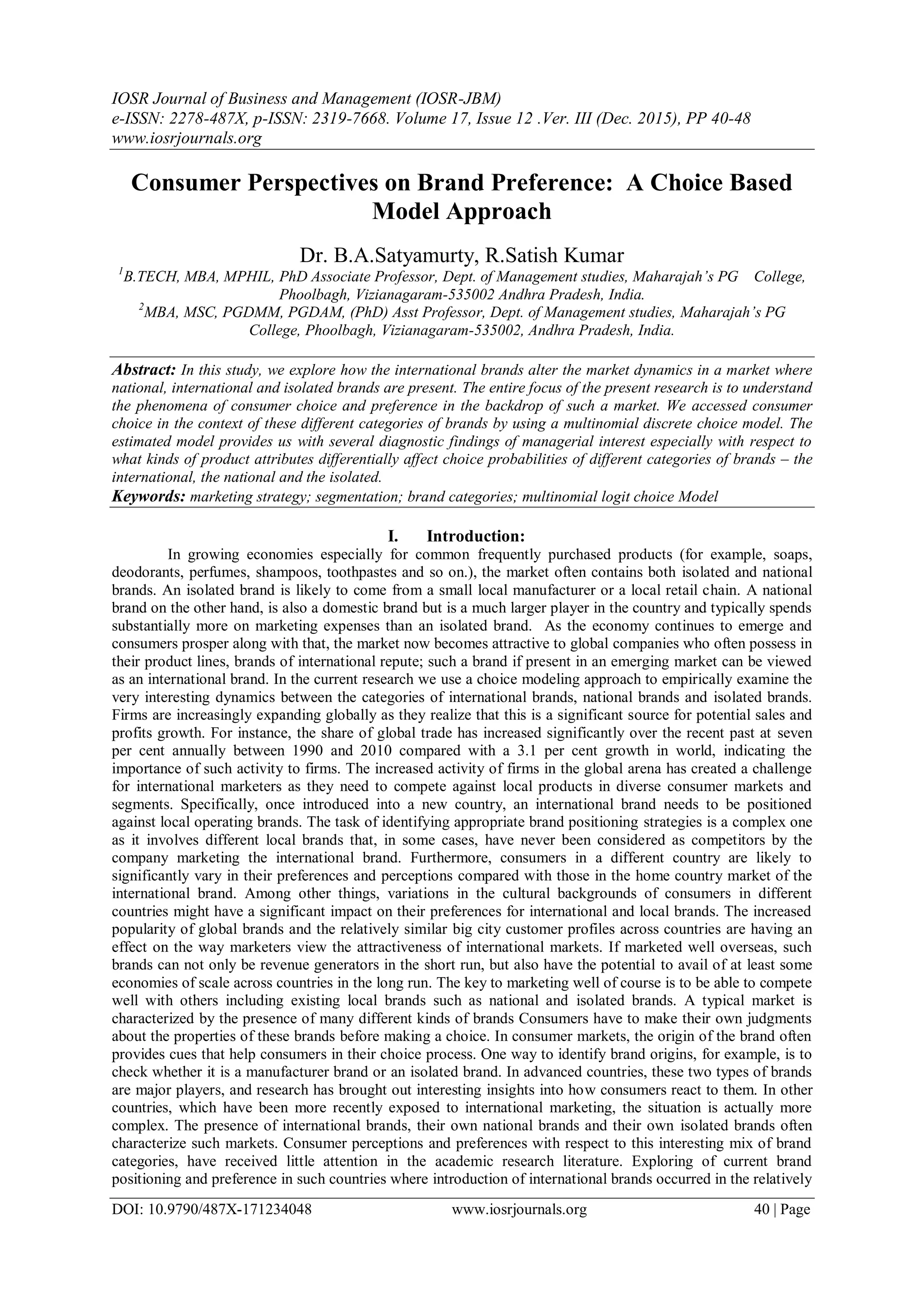
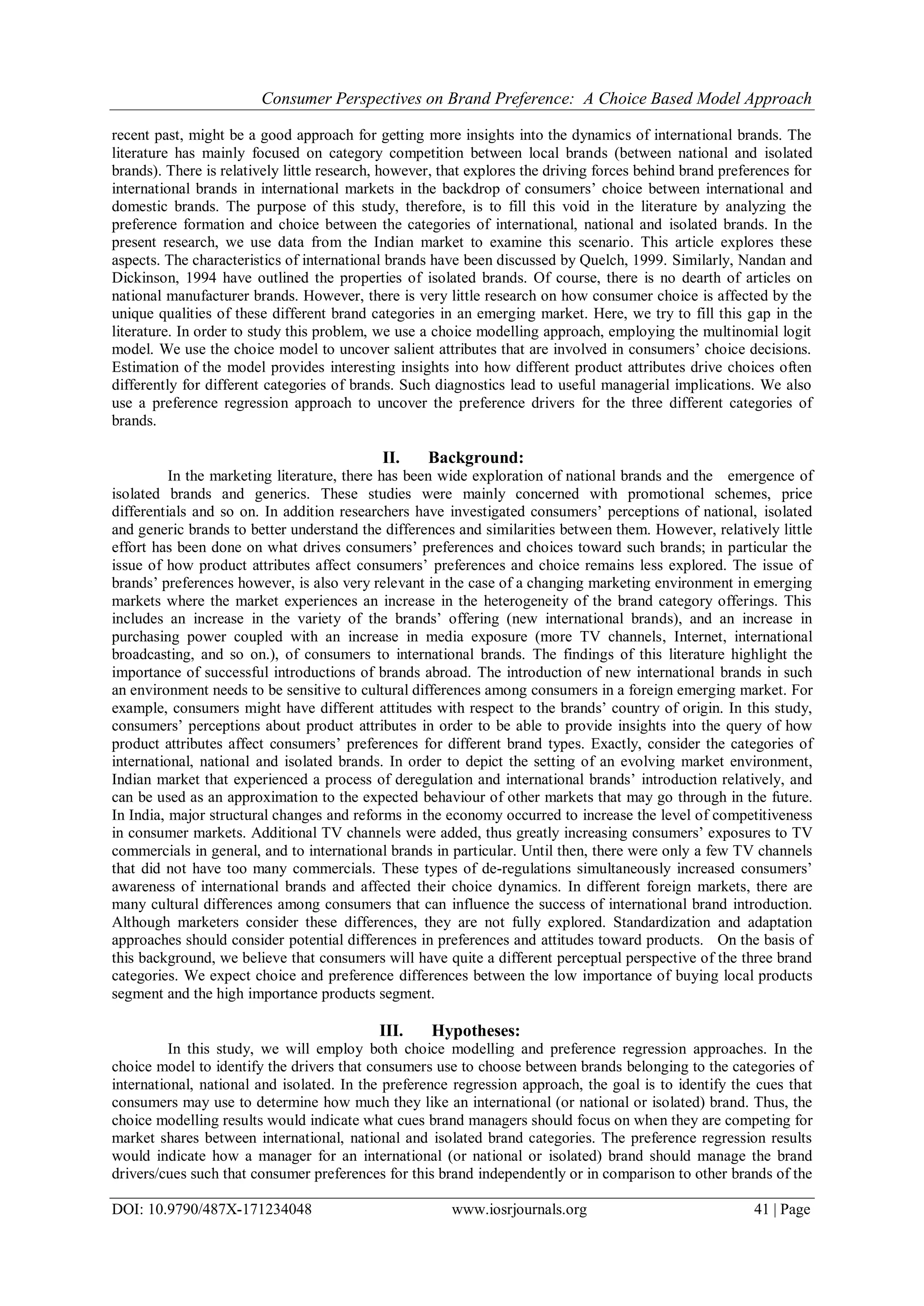
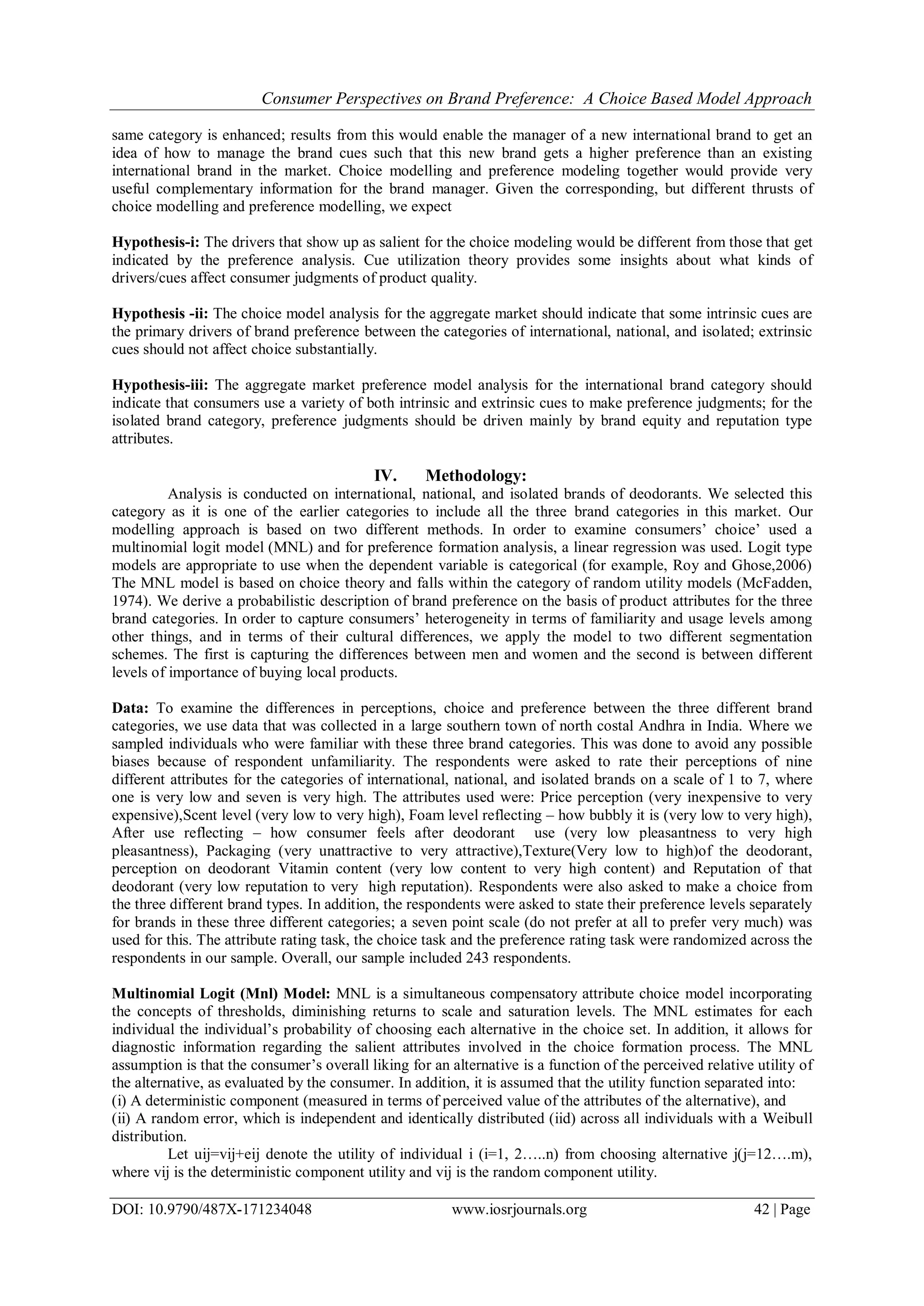
![Consumer Perspectives on Brand Preference: A Choice Based Model Approach
DOI: 10.9790/487X-171234048 www.iosrjournals.org 43 | Page
Thus, the probability pij, that an alternative j will be chosen from a set of alternatives depends only on
the deterministic component of the utility function, such that
Py = Pr [Uy=J ≥ Uy, , Cj ], and Py =
mj
1
)(
)(v
exp
exp
y)
j
v y
(1)
Where Vy =
K
j ijkk
x
1
, k
is the importance of the kth
attribute in the utility, and xijk – is threating of
consumer i of attribute k for alternative j.
Thus, the deterministic part of the utility in our case is
Vy = 1
Scentj + 2
Foamj + 3
Aftensej + 4
Packagej + 5
Varietyj + 6
Texturej + 7
Pricej +
8
Vitaminsj + 9
Reputationj (2)
And one needs to estimate the parameters
.
1
sk
The preference regression model utilizes the same product attributes but estimate the relative
importance of the different attributes in forming preference for the different brand categories separately as
follows.
Prefj = β1Scentj + β2 Foamj + β3 Aftensej + β4 Packagej + β5 Varietyj + β6 Texturej +
β7 Pricej + β8 Vitaminsj + β9Reputationj (3)
Where Prefj – is the preference for the jth
brand category where j = 1, 2, 3 and
.
1
sk
Parameters to be estimated for k=1,…., 9
Table-I: MultiNomial Logit Choice Model Coefficients: Aggregate Sample
s.no. Variable Parameter Significance level
01 Price 0.037 0.603
02 Scent 0.402 0.001
03 Foam -0.238 0.034
04 After use 0.384 0.001
05 Package 0.030 0.738
06 Variety 0.055 0.598
07 Texture 0.132 0.167
08 Vitamins -0.113 0.254
09 Reputation 0.246 0.006
10 Log likelihood
function
-172.5629 -
V. Results:
The MNL model results for choice and the regression analysis for preference formation for the three
different brand categories. From Table -I, the results of the MNL for the total sample are presented. We can
evaluate the results by dividing the different attributes into core and extrinsic attributes. This type of analysis
enables us to determine what component of the product has how much impact on the preference formation of
consumers. Thus, we separated the product’s attributes into: (a) brand equity (that is, reputation), (b) distinct
value (that is, price), (c) core attributes or intrinsic cues (that is, deodorant -related attributes such as foam,
scent, texture, and so on.) and (d) purely external attributes (that is, packaging). Items a, b and d are different
kinds of extrinsic cues. It can be seen that scent, foam, after use, and reputation are significant at least at the
Five percent level. In other words, the core attributes of the product and its brand equity are salient in the choice
process of the whole sample. In terms of goodness of fit, the model was able to classify correctly 71.2 per cent
of the observations with respect to their chosen brand category. Next, we analyze differences between men and
women as presented in Table-II. The results indicate that scent and foam are salient in the choice process of the
men segment whereas scent, after use, texture, vitamin content and reputation are salient in the women’
consumer segment. That is, men use only two core product attributes in their choice process for deodorant where
women use multiple core products attributes as well as the brand equity attribute in their choice process. These
differences clearly indicate that different marketing strategies can be effectively constructed for these two
segments which will, for example, focus on the scent and foam of the deodorant for men (highlighting the core
benefits), whereas for women more sophisticated marketing communication strategies could highlight the](https://image.slidesharecdn.com/g0171234048-160129090241/75/Consumer-Perspectives-on-Brand-Preference-A-Choice-Based-Model-Approach-4-2048.jpg)
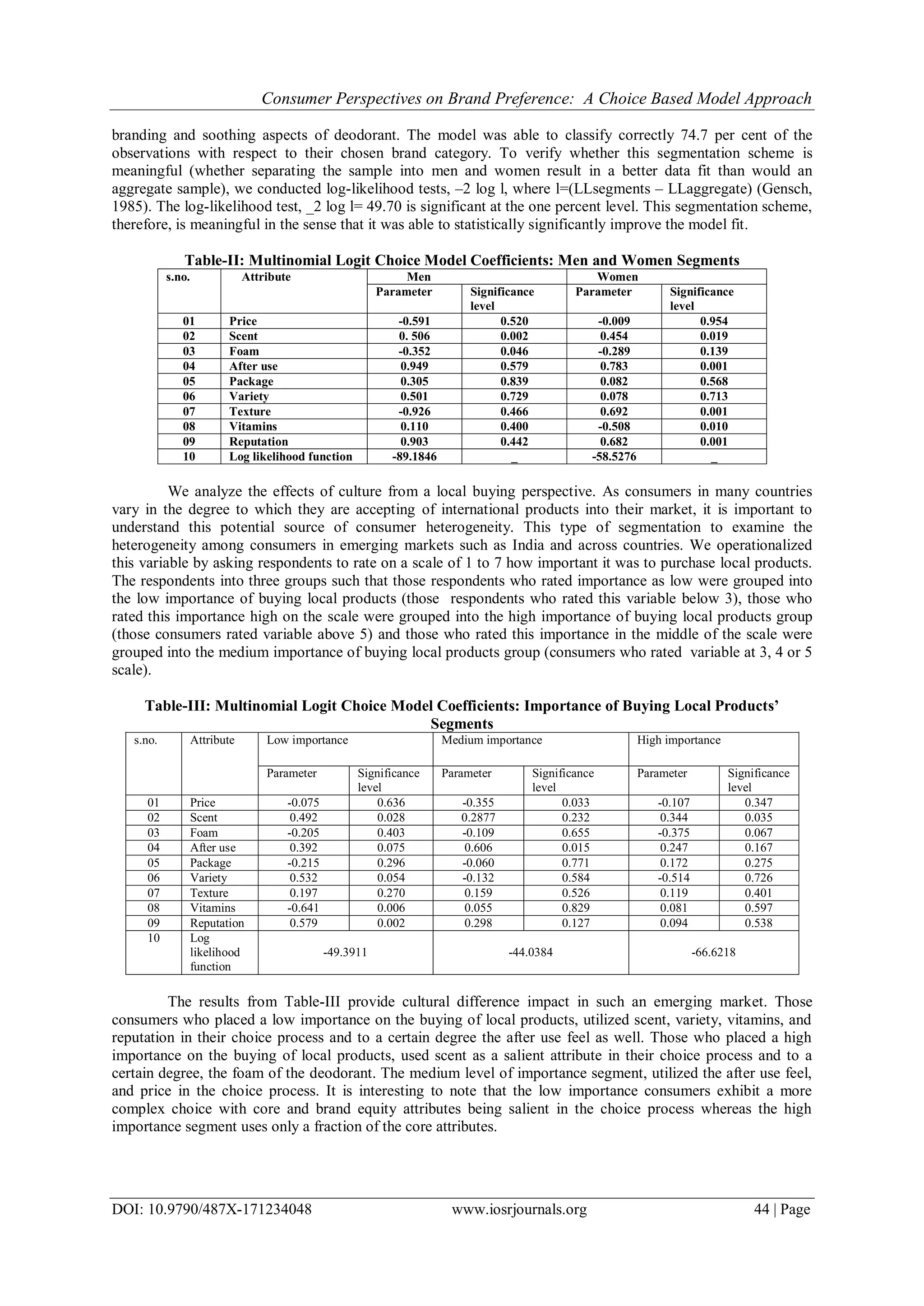

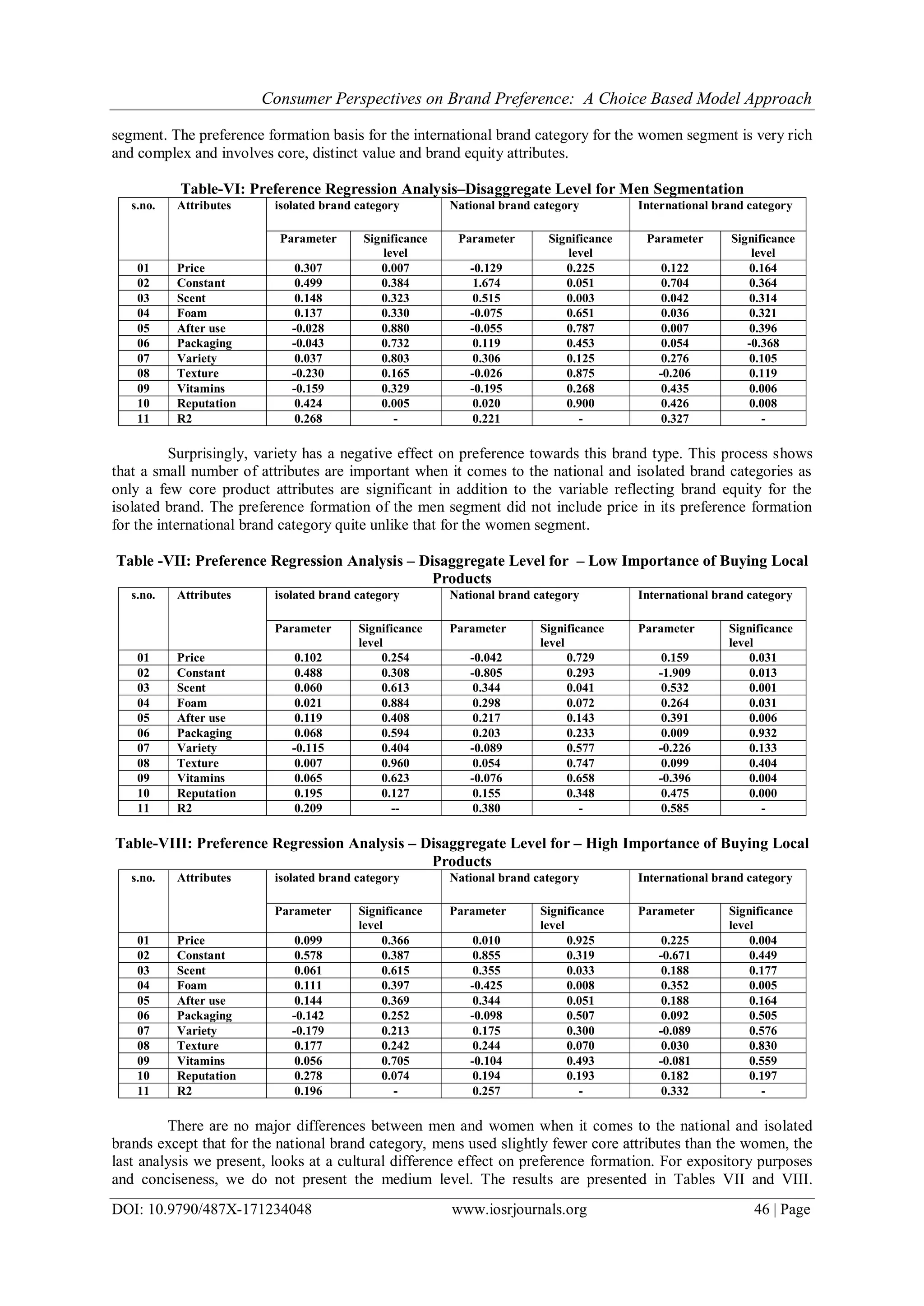
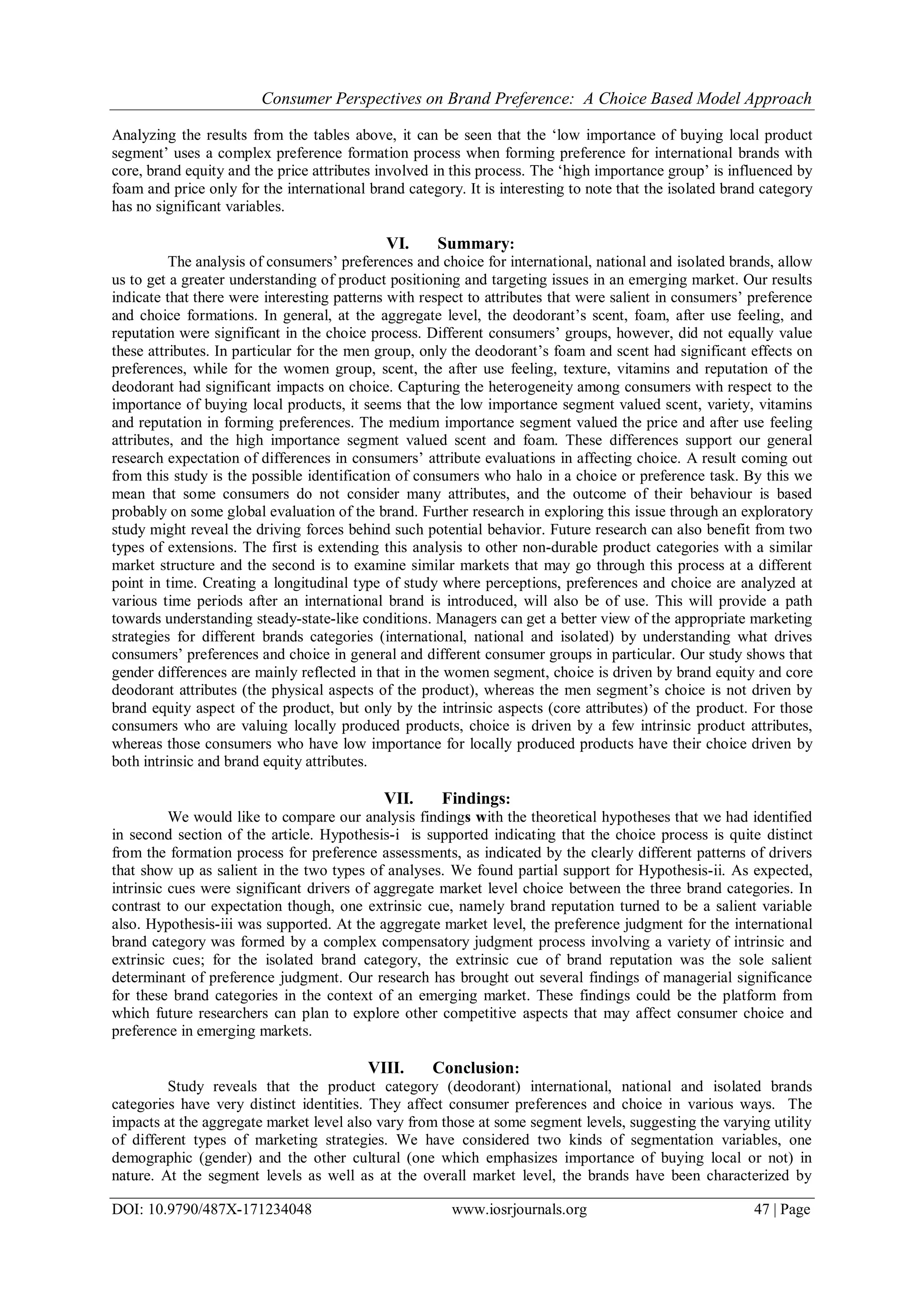
![Consumer Perspectives on Brand Preference: A Choice Based Model Approach
DOI: 10.9790/487X-171234048 www.iosrjournals.org 48 | Page
extrinsic and intrinsic product attributes as well as attributes reflecting value and brand equity. The preference
regression runs identify the drivers that are important in moulding how consumers develop a liking for a specific
brand type, when the brand is considered in an independent context. The choice modeling reveals what drivers
are important when international, national and isolated brands compete with one another for market share.
Choice modelling is closely in synch with our main objective – to understand how international, national brand
and isolated brands vie with each other to get the mind share of consumers in an emerging market. The
preference analysis provides complementary information. For instance, the latter analysis could indicate what
kinds of attributes might a new international brand (possibly a future entrant) want to stress if its goal is to gain
the preference of consumers within that category. Let us next consider an example related to the choice analysis:
For an international brand to compete with a national brand and a isolated brand, the international brand should
not waste any resources utilizing any price based strategy; this is based on the aggregate level choice analysis.
The reason is that the price variable was not significant in the choice modelling. However, in preparing for the
future entry of a new international brand, the existing international brands need to absolutely think of
considering a premium pricing policy today; this deduction follows from the positive and significant price
coefficient for the international brand category at the aggregate market level in the preference analysis.
References:
[1]. Berrell, J. (1995) Local fall in love with brands. Retail World 48(23): 8.
[2]. Blattberg, R.C. and Wisniewski, K.J. (1989) Price-induced patterns of competition. Marketing Science 8(4): 291.
[3]. Blattberg, R.C., Briesch, R. and Fox, E.J. (1995) how promotions work. Marketing Science 15(3): G122–G132. Chen, S. (2009).
[4]. De Chernatony, L.C., Halliburton, C. and Bernath, R. (1995) International branding: Demand or supply-driven opportunity?
International Marketing Review 12(2): 9.
[5]. Bellizzi, J.A., Krueckeberg, H.F., Hamilton, J.R. and Martin, W.S. (1981) Consumer perception of national, isolated, and generic
brands. Journal of Retailing 57(4): 56.
[6]. Harris, B. and Strang, R.A. (1985) Marketing strategies in the age of generics. Journal of Marketing 49(4): 70–81. Heiman, A. and
Lowengart, O. (2008) the effect of information about health hazards on demand in frequently purchased commodities. International
Journal of Research in Marketing 25(4): 310.
[7]. Hsieh, M.-H. (2004) an investigation of country-of-origin effect using correspondence analysis: A cross-national context.
International Journal of Market Research 46(3): 267.
[8]. D.B., Quelch, J.A. and Taylor, E.L. (2004) how global brands compete. Harvard Business Review, 82(9): 68–75.
[9]. Kwok, S., Uncles, M. and Huang, Y. (2006) Brand preferences and brand choices among urban Chinese consumers: An
investigation of country-of-origin effects. Asia Pacific Journal of Marketing and Logistics 18(3): 163–172.
[10]. Lal, R. (1990) Manufacturer trade deals and retail price promotions. Journal of Marketing Research 27(4): 428.
[11]. Malik, O.P. (1995) the great India bazzar. Brandweek 36(23): 31.
[12]. McGoldrick, P.J. (1984) Grocery generics – An extension of the isolated label concept. European Journal of Marketing 18(1): 5.
[13]. Mulhern, F.J. and Leone, R.P. (1991) implicit price bundling of retail products: A multiproduct approach to maximizing store
profitability. Journal of Marketing 55(4): 63.
[14]. McFadden, D. (1974) Conditional logit analysis of qualitative choice. In: P. Zarembka (ed.), Frontiers in Econometrics, New York:
Academic Press.
[15]. Nandan, S. and Dickinson, R. (1994) Isolated brands: Major brand perspective. Journal of Consumer Marketing 11(4): 18.
[16]. Olson, J. and Jacoby, J. (1973) Cue utilization in the quality perception process. In: M. Venkatesan (ed.) Proceedings 3rd
Annual
Conference. Chicago, IL: Association of Consumer Research, pp. 167.
[17]. Roy, S. and Ghose, S. (2006) Internet adoption as a two-stage transition: Converting internet non-users to internet users and to
online buyers. International Journal of Market Research 48(3): 321.
[18]. Roth, M.S. (1995) the effects of culture and socioeconomics on the performance of global brand image strategies. Journal of
Marketing Research 32(2): 163.
[19]. Sethuraman, R. (1996) A model of how discounting high-priced brands affects the sales of low-priced brands. Journal of Marketing
Research 33(4): 399.
[20]. Wilkes, R.E. and Valencia, H. (1985) A note on generic purchaser generalizations and subcultural variations. Journal of Marketing
49(3): 114.
[21]. Wall Street Journal (1997) U.S. brands gain in China. Eastern Edition, Oct 29, B6.](https://image.slidesharecdn.com/g0171234048-160129090241/75/Consumer-Perspectives-on-Brand-Preference-A-Choice-Based-Model-Approach-9-2048.jpg)